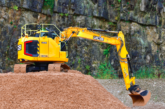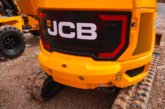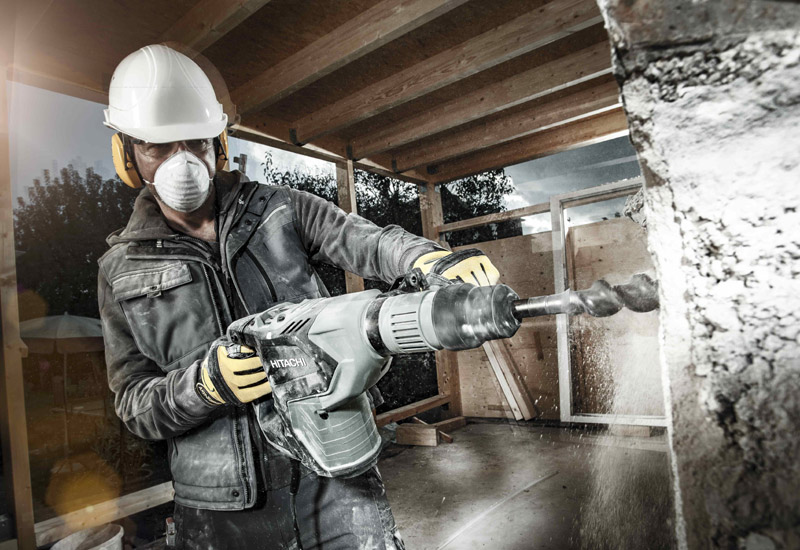
Heavy-duty breakers and brushless motors can provide more choice, power and efficiency for housebuilders and developers, explains Simon Miller, Brand and Product Manager, at Hitachi Power Tools.
When it comes to power tools, housebuilders and developers have plenty of types of tool to choose from. However, there are two categories in particular which offer significant advances in technology, providing more power and additional features than ever before. These include heavy-duty breakers, which tackle the larger demolition jobs, and highly efficient brushless power tools, which are increasing working time by up to 40 per cent. Armed with this knowledge, it’s possible for housebuilding professionals to make an informed choice on which type of tool is suitable for the job in hand.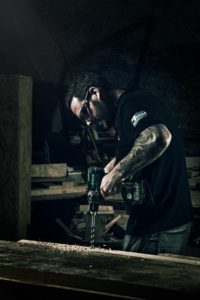
Demolition and breaking is often the first phase of redeveloping properties. Pure power is important in the tools needed for this hard and dusty work – but safety, protection and durability are also important factors to consider when choosing the right demolition tool. The powerful H90SG Heavy Duty Breaker from Hitachi, for instance, offers class leading demolition performance. Weighing in at 32kg, the breaker has impact energy of 70J and a full load impact rate of 1000/min. The breaker features a User Vibration Protection (UVP) system, which restricts the tri-axial vibration to only 7.7 m/s2. The breaker’s Aluminium Housing Body has been designed to offer greater durability on site while the low vibration handles have soft grips to further dampen vibration.
For those jobs that require a more portable hammer drill, then the DH18DBL/JP hammer drill features a brushless motor which runs for 50% longer per battery charge than Hitachi’s conventional brushed DC motor. It has impact energy of 2.6 Joules and a 26mm drilling capacity in concrete. Its three-mode action for powerful rotary drilling, hammer drilling or chiseling makes it a formidable tool for all those working out on site without mains power.
User safety
As with all Hitachi products, user safety is at the forefront: the Hammer Drill has over current protection and the Reactive Force Control (RFC) system reduces the risk of injury from tool overload. The built-in LED light means users can work in dim and tight spaces and the battery indicator means you never need to run out of charge.
Unlike the DH18DBL/JP hammer drill, traditional power tools use brushed motors where the carbon brushes are in constant contact with the commutator during use. Strong and powerful the motors may be, but the design means friction between the brushes and the commutator is unavoidable during use. The result over time is a slight drop in speed, thermal energy losses and the production of sparks and heat. This friction will also of course mean that the brushes will need to be replaced as they wear out over time with use.
Brushless motors
Brushless motors have many advantages. They can be more powerful, as there is space to make the copper windings on the outside of the motor larger and there is none of the friction energy loss during use that brushed motors inevitably suffer from. The result is a more powerful, efficient and longer lasting power tool.
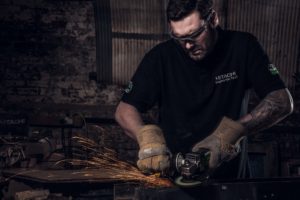 Due to the more compact design compared to brushed motors, incorporating the brushless motor permits a reduction in size and weight of tools for easier handling. Not only that, the Hitachi brushless motor has large FETs (Field Effect Transistors) and highly durable electronic circuits for superior durability. Brushless motors also improve dust proofing, which is important for installers as it gives the power tools a longer service life, saving time and money, not just in respect of cleaning the power tools, but replacing them too. The Hitachi electronic circuit board is silicone-coated to protect it from dust.
Due to the more compact design compared to brushed motors, incorporating the brushless motor permits a reduction in size and weight of tools for easier handling. Not only that, the Hitachi brushless motor has large FETs (Field Effect Transistors) and highly durable electronic circuits for superior durability. Brushless motors also improve dust proofing, which is important for installers as it gives the power tools a longer service life, saving time and money, not just in respect of cleaning the power tools, but replacing them too. The Hitachi electronic circuit board is silicone-coated to protect it from dust.
There is another important benefit of brushless motors – increased operator safety and overload protection. Brushless motors don’t generate the same heat as there are no carbon brushes and they can’t be burnt out. They also offer better protection on kick-back control when operating. Some manufacturers such as Hitachi also have power cut out technology, which keeps the operator safe too.
Cordless tools
Perhaps the area where the introduction of brushless technology has had most impact is in the cordless power tool sector. There’s nothing more frustrating than a power tool failing mid-job simply because it needs to be charged. With the huge improvement in efficiency this is no longer a pressing consideration. Brushless motors work particularly well in big cordless grinders and hammer drills because these tend to be overworked by users. Using brushless motors means the end user can have confidence that their battery will last the course.
When powerful Lithium-ion (Li-ion) battery technology is combined with the benefits of brushless motors in cordless power tool ranges, housebuilders and developers get more flexibility and choice out of their tools than ever before. Manufacturers, such as Hitachi, are leading the way in providing this combination, providing tougher, faster and more advanced power tools with quick charging times and efficient motors.
Battery options
Hitachi, for instance, recently launched its 6.0Ah battery range, which has a 20 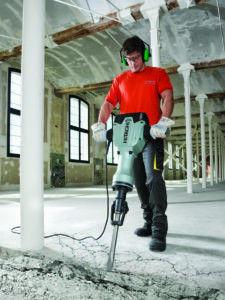 per cent longer runtime than the equivalent 5.0Ah versions. These powerful batteries charge in just 38 minutes with the new fan cooled fast charger giving users, with two batteries in their kit, an almost permanent power supply with the flexibility of cordless tools. Importantly, batteries such as Hitachi’s are lightweight too, reducing fatigue on any high volume drilling work contractors may face.
per cent longer runtime than the equivalent 5.0Ah versions. These powerful batteries charge in just 38 minutes with the new fan cooled fast charger giving users, with two batteries in their kit, an almost permanent power supply with the flexibility of cordless tools. Importantly, batteries such as Hitachi’s are lightweight too, reducing fatigue on any high volume drilling work contractors may face.
These modern 6.0Ah batteries have a long life, with up to 1500 charge cycles expected. They also feature a Multiplex Protection Circuit that prevents overload, overcharge and overdischarge, safeguarding the technology and also adding to a longer life expectancy, saving money for contractors in the long run. The best manufacturers make their batteries compatible with all of their 18V tools, meaning the tradesperson does not have to buy full replacements to take advantage of the extra power on offer.

